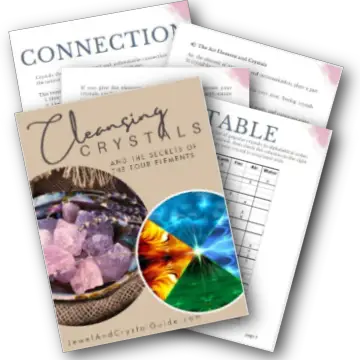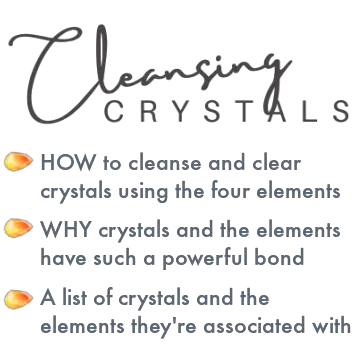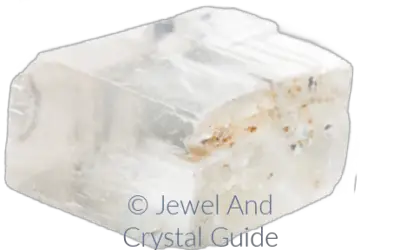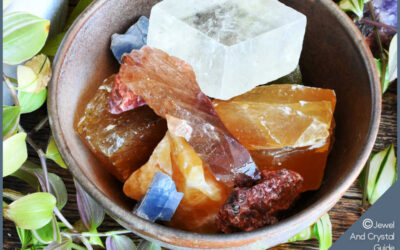Pink amethyst and rose quartz are both pale pink semi-precious gemstones from the quartz family, but there are several differences between these two crystals.
Pink amethyst is the more expensive crystal that’s pale pink from hematite. Rose quartz is cheaper and more common, but it gets its pink color from titanium, iron, and manganese. Pink amethyst usually has white and dark swirls in it once tumbled, while rose quartz has only white swirls.
Pink amethyst is a recent discovery found only in South America. Not everyone is convinced that pink amethyst is real – see the end of this post for the arguments on both sides (Is pink amethyst real?). But there are nine key differences between pink amethyst and rose quartz, which we’ll cover today…
In this article, we’ll explore:
- The 9 differences between pink amethyst and rose quartz
- A summary of these differences
- The similarities between pink amethyst and rose quartz
- A discussion on whether or not pink amethyst is real
When I refer to “pink amethyst” in this post, I’m talking about the pink crystal mined at El Choique mine in Argentina that is marketed and sold as pink amethyst.
9 differences between pink amethyst and rose quartz
Below are nine differences between pink amethyst and rose quartz. These differences will help you understand each crystal better and identify one from the other, if possible.
Pink amethyst and rose quartz are found in different areas
Pink amethyst is rare because it is found in one place in the world – in Patagonia, South America. This area falls within Chile and Argentina, and the only pink amethyst mine, called El Choique, is located in Argentina.
Pink amethyst does not come from Brazil, as many people believe.
Rose quartz is a common and popular crystal. Today, most rose quartz is mined in Brazil, India, South Africa, and Madagascar. But rose quartz has been found in many other places too, such as Australia, Egypt, Mozambique, Namibia, Sri Lanka, and the US, in places like Arkansas, California, Maine, Montana, New York, and South Dakota.
Rose quartz was found long before pink amethyst
People have used rose quartz for many thousands of years, dating all the way back to the ancient Egyptians. We know this because Egyptian mummies were buried with jewelry made with rose quartz crystals and other semi-precious stones.
It is thought that the Egyptians used rose quartz for its anti-aging properties, which is one of the reasons why rose quartz is such a wonderful crystal in face rollers.
Pink amethyst was discovered recently, around 2017, in Argentina, where a mine was set up. The crystal is dug out of the ground in geodes. Geodes are rocks with crystals growing inside their hollow centers.
Different minerals give rose quartz and pink amethyst their color
All quartz, including rose quartz and pink amethyst, is made up of the same basic elements, like silica and sodium. The only difference between the quartzes is how they get their color.
Pure quartz is clear, without any color. All other quartzes are colored by impurities or minerals that get inside the crystals when they form. When exposed to the right conditions, like radiation, there is a reaction and the impurities change the color of the quartz.
Rose quartz is pink because the impurities titanium, iron, and manganese turn the crystal this color. Click here to find out how rose quartz forms and becomes different shades of pink.
Pink amethyst gets its pale pink hue from the impurity hematite, an iron oxide.
If you want to know what makes purple amethysts purple, click here.
Rose quartz and pink amethyst have different swirls
When crystals are mined or found in nature, they are rough and jagged. These are raw crystals. The smooth crystals you see in shops and in jewelry have been tumbled in a rock tumbler, to make them that way.
A rock tumbler rolls raw crystals over and over, until they are rounder, smooth, and shiny. A raw crystal is much lighter in color than tumbled crystal, where the color is darker.
If you stop you look closely at a tumbled crystal, you’ll often see swirls of color inside.
If you hold tumbled rose quartz next to tumbled pink amethyst, you will notice that the color of their swirls is slightly different. Rose quartz has white swirls on a pale pink background. Pink amethyst has white and dark red or burgundy swirls.
Pink amethyst is more expensive than rose quartz
Pink amethyst is more expensive than rose quartz because it is rarer. You can expect to pay between $20 and $300 for a pink amethyst geode, depending on its size. A rose quartz geode costs anywhere from $15 to $70.
Pink amethyst is a fairly expensive crystal compared to most other crystals because it is rare and those who sell pink amethyst have done a good job of promoting this crystal, creating a strong desire in many to own a pink amethyst.
The price of pink amethyst and rose quartz depends a lot on where you buy them. It is cheapest to buy crystals directly from online retailers, wholesalers, and sometimes from markets (though you probably won’t find a rare pink amethyst there).
Crystals usually cost more if you buy them from traditional stores because these stores need to make enough profit to pay for rent, labor, and still make a profit.
Pink amethyst and rose quartz are different birthstones
Rose quartz is one of the birthstones for January. Wearing rose quartz or giving it as a gift is said to bring good health, love, and happiness. Because rose quartz is the stone of love, it opens the heart and improves relationships.
Pink amethyst is a pink version of purple amethyst, the birthstone for February. But because pink amethyst is a new discovery, it’s never been made a traditional birthstone.
Regardless of this, pink amethyst should be worn by Taurus, Cancer, Libra, Scorpio, Aquarius, and Pisces. Click here to find out why.
Pink amethyst and rose quartz bring different gifts
Pink amethyst and rose quartz are crystals that satisfy different desires. Rose quartz is best known for its ties with unconditional love, while pink amethyst is connected to balance and peace.
Rose quartz boosts self-esteem, creativity, and wellbeing. This crystal is the heart stone, and it’s been known to attract love, friendship and affection. It also opens one’s heart to be kinder with others and yourself, especially when you use rose quartz with affirmations and in meditation.
Rose quartz is a wonderful healing crystal and is thought to help with depression, stress relief, headaches and migraines.
Pink amethyst is believed to bring its owner comfort, stability, and greater awareness. Those who take advantage of the benefits of pink amethyst report that it helps them get through sad times, when there is great heartache.
Pink amethyst is also a healing crystal. It’s believed that pink amethyst boosts fertility and heals the body with the power of love. In contrast, purple amethyst is said to heal the carrier using the mystical realm. Click here to find out what makes pink and purple amethysts different.
Pink amethyst and rose quartz bring their own kind of love
Pink amethyst and rose quartz are both pink crystals with strong ties to the heart. But there’s a difference in how each helps the heart:
- Pink amethyst opens the heart and restores its balance and wellbeing, so life can be peaceful and filled with joy once more. Pink amethyst helps a person fall in love with their life all over again.
- Rose quartz attracts love and strengthens existing love and relationships. This crystal helps with finding a new love, making friends, and building stronger relationships with those who are already in your life.
Rose quartz is used in face rollers, pink amethyst is not
Rose quartz and purple amethyst are used to make face rollers, a popular beauty product where the user roles a crystal over their face. Pink amethyst is never used in face rollers – probably because it is too rare and expensive.
Rose quartz and jade are two of the most popular crystals in face rollers, followed by purple amethyst.
Rose quartz is so popular because it boosts blood circulation in the face, reduces redness, tightens pores, and helps the skin absorb serums and beauty products.
Table of differences between pink amethyst and rose quartz
Below is a table with a summary of all the differences between pink amethyst and rose quartz:
| PINK AMETHYST | ROSE QUARTZ |
| Pink amethyst is mined in Argentina | Rose quartz is mined in many places across the world, such as Brazil, South Africa, Madagascar, Japan, and the USA |
| Pink amethyst is a recent discovery, and was only found in 2017 | Rose quartz has been used for hundreds of years, dating back to the ancient Egyptians |
| Pink amethyst gets its pale pink hue from hematite, an iron oxide | Rose quartz is pink because titanium, iron, and manganese turn the crystal this color |
| Pink amethyst has dark red or burgundy and white swirls on its light pink coloring | Rose quartz has white swirls on a pale pink background |
| You can expect to pay between $20 and $300 for a pink amethyst geode | A rose quartz geode costs anything from $15 to $70 |
| Amethyst is the birthstone for the month of February. Because pink amethyst is a new discovery, it’s never been made a birthstone | Rose quartz is one of the birthstones for January |
| Pink amethyst is connected to balance and peace | Rose quartz is best known for its ties with unconditional love |
| Pink amethyst opens the heart and restores its balance and wellbeing | Rose quartz attracts love and strengthens existing love and relationships |
| Pink amethyst is never used in face rollers, but purple amethyst is | Rose quartz is used to make face rollers |
Similarities between pink amethyst and rose quartz
Despite all the differences between pink amethyst and rose quartz, the two crystals do share a lot of the same traits.
Both pink amethyst and rose quartz…
- belong to the quartz family
- are semi-precious gemstones
- are pale or light pink in color
- are linked to the heart chakra
- are a level 7 on the mineral hardness scale (MOHS). This means they cannot be scratched by a knife but can be scratched by harder stones, such as diamonds
- are shiny or glassy when raw from the ground
- become opaque when tumbled to be made smooth
- are used to make jewelry, including rings, earrings, necklaces, and bracelets
- can be enjoyed as décor in the home
Is pink amethyst real?
Pink amethyst is a real crystal that is mined in the El Choique mine in Argentina. It is marketed and sold in the crystal community as a special form of amethyst. Some geological experts think that pink amethyst is a real amethyst, but many experts do not agree with this.
Let’s take a look at both sides of the argument:
Many people who sell crystals call pink crystals from the El Choique mine in Argentina “pink amethyst”. Sceptics say that calling these pink pieces amethysts is simply a marketing trick to make people think they are unique and rare crystals, so customers want them and are willing to pay more for them.
Many experts do not consider pink amethyst to be real amethyst.
Quartz comes in many colors, and the name of the quartz tells you what color the quartz is. Citrine is yellow or brown quartz, rose quartz is pale pink, and amethyst is purple quartz.
So the name “amethyst” tells us that the quartz is purple, because amethyst means purple. You cannot have a pink stone called purple. When you call it “pink amethyst” you are calling the crystal “pink purple”, so is it pink or is it purple?
Well, that’s the other side of the argument…
Those who think that pink amethyst is real argue that the pale pink color is a light shade of purple, so it is a pink purple and is rightfully called a pink amethyst.
Some experts have studied pink amethyst and agree that these pieces are, in fact, pink-colored amethyst. Pink amethysts are closer in structure to amethyst than rose quartz. This is because the same impurities that give amethyst its shades of purple give pink amethyst its pale pink color, so it is a true amethyst even if it’s pink and not purple.
Click here to find out everything you need to know about pink amethyst (and more!)
Whether you think pink amethyst is a true amethyst or not, it is a beautiful crystal nonetheless and becoming more and more popular.











